

Since 2010, I am staff member of the computational astrophysics section (CAST) at the Ludwig Maximilian University Munich (LMU). I have a long-standing experience in numerical algorithm and code development. Throughout my scientific career I focused on forefront simulations of galaxy clusters and the large scale structure, and did pioneering work as member or leader of various cosmological simulation campaigns, among them performing the world's (still) largest cosmological hydro-dynamical simulation Magneticum Pathfinder.

Since 2021, my ERC Advanced group COMPLEX started, dedicated to further refine underlying models in simulation. This will enable simulations to trace the formation of very large-scale structures such as galaxy clusters, while at the same time taking processes that act on much smaller length scales (such as the physics of plasmas) into account. Thereby, we will aim at identifying the key processes responsible for determining the detailed composition of the largest known structures in the Universe.


490702358
Since December 2021 the French/German colaboration LOCALIZATION started. Using constrained, hydrodynamical simulations of the local Universe we will pave the way from precision cosmology from averaged statistics towards accurate understanding of the cosmological growth of structures. Especially we will investigate the difference between the linearly evolved amplitude of the matter power spectrum measured with the CMB and galaxy clusters, i.e. σ8 tension, as well as CMB large-scale anomalous features. Thanks to the simulations performed within the LOCALIZATION network, we will derive for the first time the exact relation between cluster masses and their observed proxies.

Since January 2022, SPACE, the EU Centre of Excelence (CoE) for high performace computingh (HPC) with a focus on astrophysical and cosmological applications has started. In Astrophysics and Cosmology (A&C) numerical simulations based on HPC are essential tools for modeling complex dynamic systems, interpreting observations, and making theoretical predictions. Contrasting the results from numerical simulations with the torrent of complex observational data that the new generations of ground- and space-based observatories will produce will be a fundamental channel to provide new insights into astronomical phenomena, formation and evolution of the universe and the fundamental laws of physics. The main specific objective of SPACE is the enabling of eight out of the most widely used European A&C HPC codes to the efficient and effective exploitation of pre-exascale systems and to prepare them for the transition to exascale and beyond.

Since 2017, I am leading the Computational Centre for Particle and Astrophysics (C2PAP) which is part of the Cluster of Excellence Universe and its successor ORIGINS. In collaboration with the Leibniz Supercomputing Centre (LRZ) we operate a computing cluster and provide key personnel which allows members of the ORIGINS cluster to keep pace and harvest the progress of the continuously broadening developments in the high-performance computing (HPC) domain.
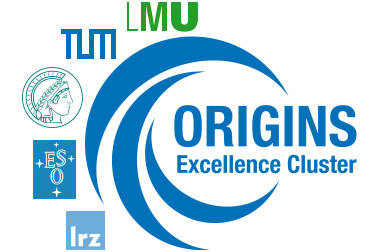
I am member of the new Excellence Cluster ORIGINS, which started 2019 and investigates the development of the Universe from the Big Bang to the emergence of life. Specifically, I am part of the Research Board, leading the C2PAP centre, and co-coordinating the connector Turbulence (CN-5) and Dark Matter (CN-3). I am also involved in the research units RU-C (Evolution of large scale structure) and RU-D (From Large Scale Structures to Galaxies) and the connectors CN-1 (Black Hole) and CN-6 (Cosmic Rays).
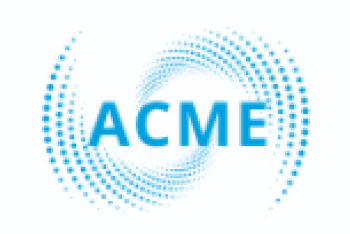
Since 2024, I'm part of the EU funded ACME project. The goal of the work package where i'm involved is to provide a hub to access models of the Local Universe to improve predictions for Astrophysical, Multi-Messenger signals. We will extend our general web services for cosmological simulations by service allowing scientists to extract all necessary information needed to model the propagation and modulation of the multi messenger signal between the sources and the observer.


Since 2020, I'm part of the EU funded AHEAD project. The goal of the work package where i'm involved is to provide trans-national access (TA) to computational astrophysics as part of the AHEAD 2020 project. This new TNA will provide new opportunities for European researchers to access free of charge complex computational astrophysical simulations, models and tools to simulate, compare, and analyse X-ray and gamma-ray data, especially fostering the Magneticum web portal.

516355818
Since 2023, I am leading the DFG project 516355818: The morphology-density relation, ram-pressure stripping and ultra-diffuse galaxies in extra high resolution galaxy cluster zoom-in simulations. The primary goal of this project is to (a) investigate how and to what extent does ram-pressure stripping in galaxy clusters contribute to the build-up of the morphology-density relation; (b) evaluate the environmental quenching mechanisms in galaxy clusters; and (c) What are possible evolutionary pathways in galaxy clusters for the formation of the recently discovered ultra-diffuse galaxies (UDGs)? To understand these connections, we will perform extremely high resolution zoom-in simulations of galaxy clusters.
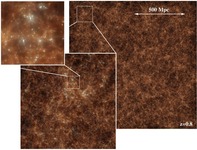
The Magneticum Pathfinder simulations are a set of hydro-dynamical simulations of different cosmological volumes aiming at following the formation of cosmological structures over a large range of cosmological scales, each of the simulations sampled with a very large number of particles providing excellent spatial resolution. They take many physical processes into account to allow detailed comparisons to a variety of multi-wavelength observational data.
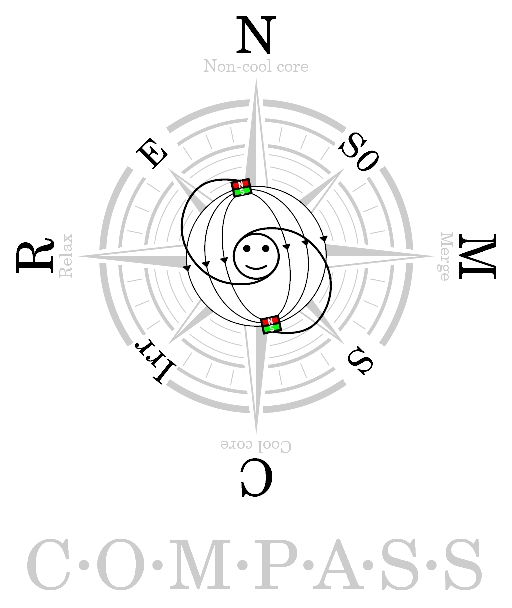
The COMPASS set of cosmological zoom simulations covers a large range of halos masses, from isolated Milky-Way mass halos to galaxy clusters of more than 1015M⊙, in unprecedented spatial and particle resolution. This set of simulations aims at studying the impact of the galaxy cluster environment on the properties of galaxies inside the cluster, bridging the gap between the high-resolution cosmological simulations which are currently too small to encompass large galaxy clusters, and the large cosmological volumes which are not well enough resolved to study the cluster galaxy properties in detail.
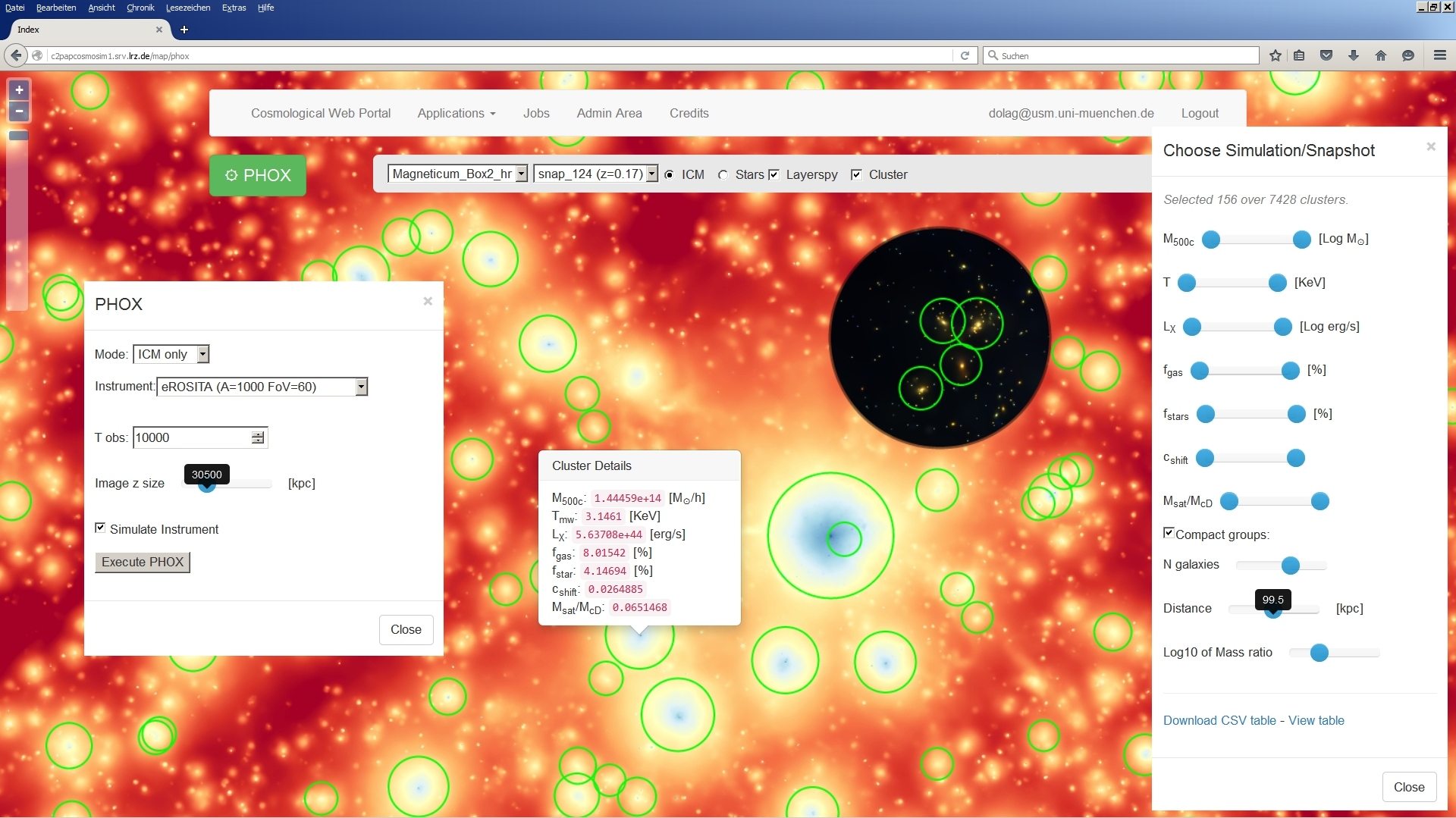
In close collaboration with the Excellence Cluster Universe and the Leibniz Supercomputing Centre (LRZ) of the Bavarian Academy of Sciences, I initiated the Cosmowebportal. This unique data centre for cosmological simulations provides access to the results of the world's most extensive set of cosmological hydrodynamic simulations, Magneticum Pathfinder. The complete simulations are saved at the LRZ in Garching on a data store for large datasets, which is connected to the supercomputer SuperMUC. Using a web interface, interested scientists can, for example, select objects from the raw simulation data, process the data, and even create virtual observations mimicking existing or future space telescopes.

What happened after the big bang? How do stars and galaxies originate? What role does dark matter play in this? How does our universe evolve? To bring such outstanding questions to the public, i lead the Magneticum Team for developing a new full-dome show Ausgerechnet! Unser Universum, which now is daily shown at the Planetarium of the Deutsches Museum. Here scientists show and explain how they have used the supercomputer SuperMUC to create elaborate and spectacular simulations to understand the evolution of our own Universe.

I am contributing to scientific careers of young scientists at various educational levels. I am supervising bachelor and master students as well as PhD students, both at the University Observatory Munich / LMU and via the International Max Planck research School on Astrophysics (IMPRS). Additionally, I contributed to the training of early stage researchers by being host for various exchange grants (MARCO-Polo, EARA, LENAC-α, HPC-Europe) and PI of DAAD exchange programs with Poland and Italy (The universe in a Box, papers).

From fall 2022 to fall 2023, i lead a CAS research group Complex views and Clues of the Universe at the
Center for Advanced Studies.
Our Cosmic Home, which is the local volume of the Universe centered on us, contains very prominently visible structures, extending over almost one billion light-years. Such structures, ranging from the Local Group over the Local Void and the most prominent galaxy clusters like Virgo, Perseus, Coma and many more, represent a formidable site where extremely detailed observations exist. Therefore, cosmological simulations of the formation of galaxies and galaxy clusters within the Local Universe, rather than any other, randomly selected part of the cosmic web, are perfect tools to test our formation and evolution theories of galaxies and galaxy clusters down to the details. However, at these detailed level, such simulations are facing various challenges, from the computational point as well as from the treatment of various physical processes needed to properly capture the evolution of galaxies and galaxy clusters. Within this CAS research group in Munich, such simulation have been refined and improved in a close collaboration with the international CLUES colaboration.

Between 2020 and 2024, I was coordinator of the LMU node for the European Training network BiD4BEST, which offered PhD training in one of the most visible areas of astrophysical research, namely the formation of supermassive black holes in galaxies. I was leading the work package WP4 on Models to Observations and hosted ESR-13, who works on AGN evolution processes and galaxy formation physics in cosmological, multiscale hydro-dynamical simulations.

From 01.02.2021 to 31.01.2023, I was the host for the

The Excellence Cluster Origin and Structure of the Universe was established at the Technische Universität München (TUM) in October 2006 within the framework of the so called Excellence Initiative and was initially committed to run for five years. In 2012, the funding of this unique and internationally recognized Research Center was renewed for another five years until 2017 and received bridging funding from the German Research Foundation (DFG) till 31 December 2018. Since the renewal i was involved in the C2PAP infrastructure and contributed to several of the research areas.

LOFAR, the Low Frequency Array, is a new-generation radio telescope under construction in the Netherlands, Germany and other European countries. Its unprecedented sensitivity and angular resolution will opened a new window to the low-frequency sky that has been largely neglected in the past. The Research Unit 1254, Magnetisation of Interstellar and Intergalactic Media: The Prospects of Low-Frequency Radio Observations investigate the distribution and origin of weak, extended magnetic fields in the Milky Way, nearby galaxies and galaxy clusters. I participated in the sub project D4, where we we used Gadget to performed global simulations of the evolution of galaxies and to model their evolution within a cosmological context.

Solving the enigmas surrounding Dark Matter and Dark Energy, which together account for over 95 percent of the energy density of our universe, is a crucial research objective in modern-day theoretical and experimental physics, and was adressed by the Transregional Collaborative Research Centre Bonn - Heidelberg - Munich (TR33). I was a project leader within the project Probing Dark Matter and Dark Energy with observations of the evolution and spatial distribution of galaxy clusters (B07).
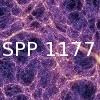
The Priority Programme SPP 1177 Witnesses of Cosmic History: Formation and Evolution of Black Holes, Galaxies and Their Environments was targeted for a detailed study of the cosmological evolution of galaxies, the relation of different properties of a galaxy to its environment, and furthermore the origin and consequences of the black holes which seem to exist in the centre of nearly every galaxy. Here i was the principial investigator of the project Intra cluster MAGnetic fields origiNATing from star formatION processes (IMAGINATION), with the goal to investigate the coupling of the magnetic field to the cooling and star formation processes and to studied the dynamical importance of magnetic fields in the so-called cooling flow regions in the centers of clusters and proto-galactic environments.

415510302
Between 2019 and 2023, I was the host for the DFG project 415510302 of Veronica Biffi. In this project we studied the interaction between cluster galaxies and the intra-cluster medium, the main feedback mechanisms (both thermal and chemical) inside galaxy clusters, the dynamics of the gas and its relation to global cluster properties and masses, and the expected X-ray properties of the diffuse gas, both inside galaxy clusters and around single galaxies within clusters and in the field. X-ray observational-like quantities will be computed through the application of our X-ray photon simulator (PHOX) to the numerical simulations, with the purpose of reproducing data in a fashion similar to X-ray current and up-coming instruments, like Chandra, eRosita and Athena.

223765867
Being the largest gravitationally-bound objects in the Universe, galaxy clusters can be treated as cosmological probes to constrain the underlying cosmological model. With special attention to the statistical treatment, we studied in the DFG project 223765867 the strong gravitational lensing signal of galaxy clusters and investigated its predictive power to infer cosmological parameters from such observations. Using the full power of cosmological simulations, we thereby investigated the effect of the selection function of the underlying galaxy clusters sample, the change of the gravitational lensing signal due to the complex baryonic processes as well as the other uncertainties arising from evolution and sub-selection of clusters by their observed dynamical state.


Between 2002 and 2004 I worked as PostDoc at the Dipartimento di Astronomia of the Universita degli studi di Padova in Italy, where I was improving numerical methods, working on simulation the local universe and worked on creating initial condition for galaxy cluster simulations.

I obtained my PhD in 2000 at the Max Planck Institute for Astrophysics in Garching (Germany), where I was also a PostDoc from 2000 to 2002, and from 2004 to 2010, where I focused on forefront simulations of galaxy clusters and large scale structures. Especially, I worked on including the treatment of magnetic fields and dark energy in galaxy cluster simulations.